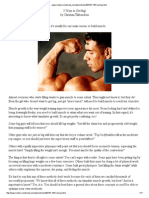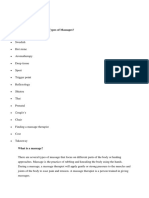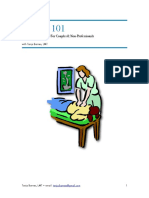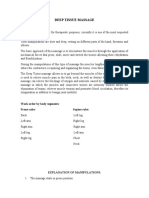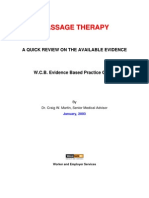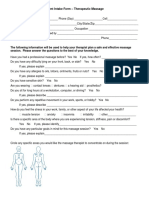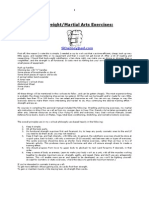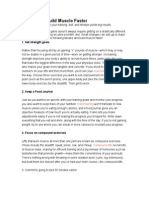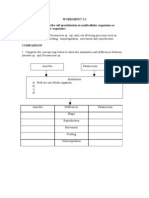100%(1)100% found this document useful (1 vote)
2K viewsBasic Massage
Basic Massage
Uploaded by
Alex OlivarMassage therapy involves manipulating the soft tissues of the body through techniques like applying pressure or causing movement. Massage provides benefits such as increased flexibility, relief of stress, improved circulation, and faster healing. Certain medical conditions contraindicate massage. Common massage strokes include effleurage, petrissage, friction, tapotement, and vibration. Fifteen laws of a good massage are outlined, and important things to remember include proper hand care, good posture, and positioning the patient comfortably.
Copyright:
© All Rights Reserved
Available Formats
Download as DOCX, PDF, TXT or read online from Scribd
Basic Massage
Basic Massage
Uploaded by
Alex Olivar100%(1)100% found this document useful (1 vote)
2K views3 pagesMassage therapy involves manipulating the soft tissues of the body through techniques like applying pressure or causing movement. Massage provides benefits such as increased flexibility, relief of stress, improved circulation, and faster healing. Certain medical conditions contraindicate massage. Common massage strokes include effleurage, petrissage, friction, tapotement, and vibration. Fifteen laws of a good massage are outlined, and important things to remember include proper hand care, good posture, and positioning the patient comfortably.
Original Description:
massage lecture
Copyright
© © All Rights Reserved
Available Formats
DOCX, PDF, TXT or read online from Scribd
Share this document
Did you find this document useful?
Is this content inappropriate?
Massage therapy involves manipulating the soft tissues of the body through techniques like applying pressure or causing movement. Massage provides benefits such as increased flexibility, relief of stress, improved circulation, and faster healing. Certain medical conditions contraindicate massage. Common massage strokes include effleurage, petrissage, friction, tapotement, and vibration. Fifteen laws of a good massage are outlined, and important things to remember include proper hand care, good posture, and positioning the patient comfortably.
Copyright:
© All Rights Reserved
Available Formats
Download as DOCX, PDF, TXT or read online from Scribd
Download as docx, pdf, or txt
100%(1)100% found this document useful (1 vote)
2K views3 pagesBasic Massage
Basic Massage
Uploaded by
Alex OlivarMassage therapy involves manipulating the soft tissues of the body through techniques like applying pressure or causing movement. Massage provides benefits such as increased flexibility, relief of stress, improved circulation, and faster healing. Certain medical conditions contraindicate massage. Common massage strokes include effleurage, petrissage, friction, tapotement, and vibration. Fifteen laws of a good massage are outlined, and important things to remember include proper hand care, good posture, and positioning the patient comfortably.
Copyright:
© All Rights Reserved
Available Formats
Download as DOCX, PDF, TXT or read online from Scribd
Download as docx, pdf, or txt
You are on page 1of 3
Massage Therapy
Massage therapy is the scientific manipulation of
the soft tissues of the body for the purpose of
normalizing those tissues and consists of manual
techniques that include applying fixed or
movable pressure, holding, and/or causing
movement of or to the body.
Benefits:
Greater flexibility and range of motion
Increase of the ease and efficiency of
movement
Relief of stress and aide of relaxation
Promotion of deeper and easier breathing
Improvement of the circulation of blood
and movement of lymph
Promotion of faster healing of soft tissue
injuries
Creation of a feeling of well-being
Contraindication:
Heart conditions (advanced heart failure,
hypertension etc.)
Phlebitis, thrombosis and embolism
Kidney failure
Cancer and chemotherapy
Fracture and dislocation
Massage should not be used locally on
affected areas for the following
conditions: rheumatoid arthritis flare up,
eczema, goiter, and open skin lesions.
Precautions should be taken before using
massage for the following conditions:
pregnancy, high fevers, osteoporosis,
diabetes, recent postoperative cases in
which pain and muscular splinting
Massage Strokes:
1. Effleurage - any stroke that glides over
the skin without attempting to move the
muscle beneath. Apply firm even
pressure. Effleurage strokes are usually
directed toward the heart.
o Is used more than any other stroke
o Usually begins and ends each
treatment
o Used as a bridge between many
strokes
o Accustoms the patient to the touch of
the operator
o Allows the operator to search for
areas of spasms and soreness
o Allows the operator to become
familiar with the condition of the
patient's muscles
o Increases circulation to the skin and
more superficial muscles
o Bilateral effleurage, Alternating Hand
Effleurage (Shingles), Raking, Nerve
Strokes
2. Petrissage - a stroke that picks up the
muscle and squeezes it. Usually done with
two hands, alternating between each
hand, but can be done with one hand.
o Milks the muscle of waste products
o Can help to free adhesions
o Increases circulation and nutrition to
the muscle
o Along with effleurage can be
considered a complete back massage
3. Friction - Friction is a stroke that pokes
through the skin and massages the
underlying muscles. While doing friction
"put on the skin like a glove" to reach
through it and massage the muscles. Ask
the patient frequently if you are deep
enough or if you are too deep. Always do
friction on the opposite side of the spine
from where you are standing. Strokes are
usually done in the direction of the
muscle fibers
o Works the deeper tissues Breaks up
adhesions
o Breaks up "knots"
o Increase circulation to the muscles
o Thumb Friction, Fingertip Friction,
Cresting Friction, Palm Friction,
Alternating Thumb Friction, Cross
Fiber Friction (Peeling)
4. Tapotement - any stroke that "strikes"
the skin. Usually a series of brisk blows.
o Can be used to excite the nerves
o Can be used to calm the nerves
o Increases circulation
o Used in hospitals for bronchitis,
pneumonia, and other like conditions
to release mucus from the lungs
o Hacking, Cupping, Pincement, Beating
5. Vibration - a vibrating/shaking
movement. Can be done to the skin or an
entire limb or even the whole trunk.
o Relaxes the patient
15 Laws of a Good Massage
1. Wash hands before every massage.
2. Make sure fingernails are trimmed and filed.
3. Do not use cold hands (if necessary warm
hands with warm water).
4. Take off watches and all other items that might
scratch the patient.
5. Use a clean room to give the massage in.
6. Do not over or under lubricate the patient.
7. Put a pillow under the patients ankles.
8. Never take your hands off the patient after you
start the massage.
9. Always massage a muscle that is relaxed.
10. Never cross the spine with pressure when
you are giving the massage.
11. Massage on the opposite side that you're
working on when your doing friction.
12. Always work toward the head.
13. Never massage in a untidy or cluttered room.
14. Use good posture while giving the massage.
15. Always remember to get feedback from the
patient.
Things to Remember:
1. Care of the Hands
The hands are the most valuable tools a massage
therapist has. They should be taken care and
kept in a presentable manner. The fingernails
should be kept short, filled and clean. The hands
should be washed before and after each massage
so that you don't transfer the diseases from one
patient to another. The hands should be warm
when you give the massage. Be careful not to do
any activities that might give you a blister before
you give a massage.
2. Posture
Remember to maintain good posture while
giving a massage. When your giving 3 or 4
massages a day having good posture makes a
difference in the way you'll feel at the end of the
day. Stand erect and have your feet spread a part
shoulder length. Instead of stooping to give
strokes that require you to be closer to the
patient (like tapotement & petrissage) spread
your legs apart more. Give a massage on a table
that is the proper height for you (A good test is to
stand erect, arms at your sides, and if the table is
about where your palms begin then it is fine.) By
following the rules of posture you will keep
yourself from needing a massage at the end of
the day.
3. Positioning the patient
The patient should be in a position that will
allow him to be relaxed while he is receiving the
massage. Make sure the patient is comfortable
and not lying bent to one side. Put a pillow under
the patient's ankles to ensure that his feet are
comfortable. The muscle that you are massaging
should be completely relaxed. Ask the patient
before beginning the massage if he is
comfortable and if there is anything that he
needs. People are very timid when it comes to
massage therapists and they rarely complain.
They might be in a very uncomfortable position
yet not say anything because they think that you
might have put them in that position for a
reason. Always remember to keep good
communication with the patient.
You might also like
- Swedish Massage StepsDocument4 pagesSwedish Massage StepsIon Logofătu Albert75% (4)
- Client Intake Form - Therapeutic Massage: Personal InformationDocument4 pagesClient Intake Form - Therapeutic Massage: Personal InformationANT lib100% (2)
- A Massage Therapist's Guide To Business, 2012 PDFDocument290 pagesA Massage Therapist's Guide To Business, 2012 PDFGeorge Erdic100% (3)
- Professionalism in Massage Therapy Resource Manual PDFDocument122 pagesProfessionalism in Massage Therapy Resource Manual PDFA.g. Shakib100% (1)
- Swedish Massage AbbreviationsDocument4 pagesSwedish Massage AbbreviationsharmziieNo ratings yet
- Intake FormDocument1 pageIntake Formapi-358259684No ratings yet
- Massage TherapyDocument12 pagesMassage TherapyChedan B. Ceriaco100% (2)
- Contraindications For Massage TherapyDocument5 pagesContraindications For Massage TherapyAnushree DatarNo ratings yet
- Swedish Massage 1 of 3 Ryan HoymeDocument31 pagesSwedish Massage 1 of 3 Ryan HoymeJDiscreet Auhbi100% (4)
- Indian Head MassageDocument49 pagesIndian Head MassagekoekemoerNo ratings yet
- Hot Stone Release FormDocument1 pageHot Stone Release FormTori BaileyNo ratings yet
- ANIMAL CELLS AND TISSUES Lecture Notes PDFDocument17 pagesANIMAL CELLS AND TISSUES Lecture Notes PDFAnonymous HXLczq383% (6)
- HOPE Grade 11 First Quarter ExaminationDocument2 pagesHOPE Grade 11 First Quarter ExaminationJoylass Pasac84% (19)
- Christian Thibaudeau - 3 Ways To Get Big!Document17 pagesChristian Thibaudeau - 3 Ways To Get Big!GymRat2269100% (1)
- Soft Tissue MobilizationDocument53 pagesSoft Tissue MobilizationBisakha Bajracharya0% (1)
- NCM 103a Module 12 Massage PDFDocument4 pagesNCM 103a Module 12 Massage PDFJenieffer PescadorNo ratings yet
- Therapeutic MassageDocument46 pagesTherapeutic MassageBonbon Kim100% (4)
- Therapeutic Massage: Muthuukaruppan MDocument42 pagesTherapeutic Massage: Muthuukaruppan Mmuthuu50% (2)
- Massage TherapyDocument26 pagesMassage TherapyChum del Rosario100% (1)
- Relax Massage - TranslatedDocument30 pagesRelax Massage - Translatedsoula90No ratings yet
- What Is Deep Tissue MassageDocument1 pageWhat Is Deep Tissue MassagelisniskytherapiesNo ratings yet
- Theory For MassageDocument16 pagesTheory For MassageAnnaya KhanNo ratings yet
- What Is Hot Stone Massage PDFDocument1 pageWhat Is Hot Stone Massage PDFlisniskytherapiesNo ratings yet
- Trigger Points FaqDocument3 pagesTrigger Points FaqGeorge CiucaNo ratings yet
- What Are The Different Types of Massages?Document14 pagesWhat Are The Different Types of Massages?VamshiNo ratings yet
- Client InformationDocument2 pagesClient InformationJonathanAllenLMTNo ratings yet
- Swedish Massage SlideDocument21 pagesSwedish Massage SlideRely Flores100% (2)
- Massage 101Document33 pagesMassage 101Vladislav Kotov100% (1)
- 10 Types of MassageDocument3 pages10 Types of MassageArt Brix100% (1)
- Massage PointsDocument35 pagesMassage Pointspeejayjacinto100% (15)
- Introduction To Massage TherapyDocument2 pagesIntroduction To Massage TherapysalimhillNo ratings yet
- 5 Myths and Truths About Massage Therapy FinalDocument50 pages5 Myths and Truths About Massage Therapy FinalElma McGouganNo ratings yet
- Swedish MassageDocument3 pagesSwedish MassageCristopher Valenzuela100% (1)
- The Physiological Effects of MassageDocument3 pagesThe Physiological Effects of Massageanny100% (1)
- Facial MassageDocument14 pagesFacial MassageEthel Adia AlvarNo ratings yet
- Sinus Massage By: Sushumna Mahesh What Is Sinus Pain?Document5 pagesSinus Massage By: Sushumna Mahesh What Is Sinus Pain?Julenda NikijuluwNo ratings yet
- Massage Therapy Client Intake FormDocument4 pagesMassage Therapy Client Intake FormEverly Oballo100% (1)
- Chapter04 Massage TechniquesDocument40 pagesChapter04 Massage TechniquesRonn Llave100% (2)
- S.O.A.P. Notes: Symptoms: Location/intensity/duration/frequency/onsetDocument1 pageS.O.A.P. Notes: Symptoms: Location/intensity/duration/frequency/onsetPeter Sosa0% (1)
- Massage Practices - Revision: PracticalDocument5 pagesMassage Practices - Revision: Practicalsimone dumbrellNo ratings yet
- Contraindications For Massage Therapy PDFDocument5 pagesContraindications For Massage Therapy PDFJennylyn100% (2)
- Deep Tissue MassageDocument5 pagesDeep Tissue MassageNanokoSanchezOrtizNo ratings yet
- Business & Insurance Info: PresentsDocument17 pagesBusiness & Insurance Info: PresentsАлексNo ratings yet
- Massage Therapy EvidenceDocument7 pagesMassage Therapy EvidenceRashoode Al-mezieneNo ratings yet
- Swedish MassageDocument22 pagesSwedish Massagealejandro jean100% (5)
- Corporate Chair Massage Brochure IIDocument1 pageCorporate Chair Massage Brochure IIastroNo ratings yet
- Neck & Back Care: Michelle KwongDocument62 pagesNeck & Back Care: Michelle Kwonginragm100% (1)
- Frozen Shoulder MassageDocument11 pagesFrozen Shoulder Massagerheuuuu50% (2)
- Massage FactsDocument3 pagesMassage Factstnelson65No ratings yet
- An Introduction To Myofascial Massage 2011Document86 pagesAn Introduction To Myofascial Massage 2011Marji Berkman100% (1)
- Muscle Test Summary - 230613 - 232607Document14 pagesMuscle Test Summary - 230613 - 232607عثمان عابدينNo ratings yet
- Effects of Massage On Body Systems - Muscular, Nervous, Circulatory ...Document9 pagesEffects of Massage On Body Systems - Muscular, Nervous, Circulatory ...Mona100% (1)
- Complete Guide To Modern Massage Step - Ryan Jay HoymeDocument222 pagesComplete Guide To Modern Massage Step - Ryan Jay HoymeKAYKAYABUEL100% (1)
- Structured Touch MassageDocument5 pagesStructured Touch Massagegfrankel72No ratings yet
- S. Cole HW499 Unit 5 Power Point Massage TherapyDocument9 pagesS. Cole HW499 Unit 5 Power Point Massage TherapySifon Cole100% (1)
- The Theory and Techniques of Cupping TherapyDocument9 pagesThe Theory and Techniques of Cupping TherapymandrakeNo ratings yet
- What Is Facial Massage PDFDocument1 pageWhat Is Facial Massage PDFlisniskytherapiesNo ratings yet
- Backache PDFDocument173 pagesBackache PDFteammrau100% (9)
- Chair Massage Intake FormDocument1 pageChair Massage Intake FormsarahNo ratings yet
- The Possible Mechanisms of Massage TherapyDocument6 pagesThe Possible Mechanisms of Massage TherapyDinyoga Bima WaskitoNo ratings yet
- Client Intake Form - Therapeutic MassageDocument2 pagesClient Intake Form - Therapeutic MassagePeter Sosa100% (1)
- Principles of Soft Tissue ManipulationDocument55 pagesPrinciples of Soft Tissue ManipulationAvinash KomaraNo ratings yet
- Nursing Licensure Exam Review: List of ParticipantsDocument1 pageNursing Licensure Exam Review: List of ParticipantsAlex OlivarNo ratings yet
- HwaDocument4 pagesHwaRgen Al VillNo ratings yet
- Compensations and BenefitsDocument12 pagesCompensations and BenefitsAlex OlivarNo ratings yet
- Amb Wonder Development Academy, Inc.: Barangay Tanod's Assistance in Maintaining Peace and Order For The Said OccasionDocument1 pageAmb Wonder Development Academy, Inc.: Barangay Tanod's Assistance in Maintaining Peace and Order For The Said OccasionAlex OlivarNo ratings yet
- CHN1Document7 pagesCHN1Alex OlivarNo ratings yet
- Medal RequestDocument1 pageMedal RequestAlex OlivarNo ratings yet
- #4 Aquino 2nd Street, Victoria Compound, St. Michael, Taguig City. Contact # 09398285721Document2 pages#4 Aquino 2nd Street, Victoria Compound, St. Michael, Taguig City. Contact # 09398285721Alex OlivarNo ratings yet
- Hon. Mayor Ma. Laarni CayetanoDocument2 pagesHon. Mayor Ma. Laarni CayetanoAlex OlivarNo ratings yet
- Amb Wonder Development Academy, IncDocument2 pagesAmb Wonder Development Academy, IncAlex OlivarNo ratings yet
- Amb Wonder Development Academy, IncDocument1 pageAmb Wonder Development Academy, IncAlex OlivarNo ratings yet
- Amb Wonder Development Academy, IncDocument3 pagesAmb Wonder Development Academy, IncAlex OlivarNo ratings yet
- Healthcare Professionals Qualification Requirements (PQR) 2014-1Document123 pagesHealthcare Professionals Qualification Requirements (PQR) 2014-1JerilNo ratings yet
- Falling StarDocument1 pageFalling StarAlex OlivarNo ratings yet
- #4 Aquino 2nd Street, Victoria Compound, St. Michael, Taguig City. Contact # 09398285721Document2 pages#4 Aquino 2nd Street, Victoria Compound, St. Michael, Taguig City. Contact # 09398285721Alex OlivarNo ratings yet
- Normal Values Normal Values Normal Values: Abg: UrinalysisDocument2 pagesNormal Values Normal Values Normal Values: Abg: UrinalysisAlex OlivarNo ratings yet
- DISCLAIMER: The Person Who Compiled This Material Does Not OwnDocument1 pageDISCLAIMER: The Person Who Compiled This Material Does Not OwnAlex OlivarNo ratings yet
- Batch 16 Batch 17 Batch 18 Batch 19 Batch 20 Batch 21 Batch 22 Batch 23Document2 pagesBatch 16 Batch 17 Batch 18 Batch 19 Batch 20 Batch 21 Batch 22 Batch 23Alex OlivarNo ratings yet
- Nle Coverage: Nursing Practice IDocument3 pagesNle Coverage: Nursing Practice IAlex OlivarNo ratings yet
- KRC School of Practical Nursing Guadalupe, Makati City: Request For Make-Up Classes/Change of ScheduleDocument2 pagesKRC School of Practical Nursing Guadalupe, Makati City: Request For Make-Up Classes/Change of ScheduleAlex OlivarNo ratings yet
- Pharmacology Pharmacology Diet: Drug of ChoiceDocument2 pagesPharmacology Pharmacology Diet: Drug of ChoiceAlex OlivarNo ratings yet
- Positioning Positioning Diet: LegendDocument2 pagesPositioning Positioning Diet: LegendAlex OlivarNo ratings yet
- Functional Matrix Revisited 2 PDFDocument6 pagesFunctional Matrix Revisited 2 PDFPranshu MathurNo ratings yet
- Learning: St. Mary's College of Tagum, IncDocument7 pagesLearning: St. Mary's College of Tagum, IncSHENIVEL BANTENo ratings yet
- Embryology Muscularskeletal SystemDocument28 pagesEmbryology Muscularskeletal SystemLale Yuni WulandariNo ratings yet
- Gracies 2Document20 pagesGracies 2Andrea TorquatiNo ratings yet
- Martial Arts - Bodyweight Exercises - Compiled Version of Matt Fureys BooksDocument36 pagesMartial Arts - Bodyweight Exercises - Compiled Version of Matt Fureys Booksbigdad626100% (6)
- Updated Nov 2019 Training Volume Landmarks For Muscle GrowthDocument11 pagesUpdated Nov 2019 Training Volume Landmarks For Muscle GrowthÁngel Del Olmo Martínez100% (1)
- 10 Ways To Build Muscle FasterDocument3 pages10 Ways To Build Muscle FasterJohn PageNo ratings yet
- Lesson PlanDocument13 pagesLesson Planapi-276183071100% (1)
- DOMS Indicador de EFECTIVIDADDocument12 pagesDOMS Indicador de EFECTIVIDADNicolás ManonniNo ratings yet
- Full (Original PDF) Human Physiology by Bryan H. Derrickson PDF All ChaptersDocument25 pagesFull (Original PDF) Human Physiology by Bryan H. Derrickson PDF All Chaptersdurieziwama100% (5)
- Effects of Physioball and Conventional Floor Exercises On Early Phase Adaptations in Back and Abdominal Core Stability and Balance in Women 2003Document5 pagesEffects of Physioball and Conventional Floor Exercises On Early Phase Adaptations in Back and Abdominal Core Stability and Balance in Women 2003rdkelsallNo ratings yet
- Worksheet 2.2Document8 pagesWorksheet 2.2izazuanNo ratings yet
- Manual: Natural Therapy For Flexibility, Relaxation and Energy BalanceDocument222 pagesManual: Natural Therapy For Flexibility, Relaxation and Energy Balancecatalin100% (1)
- The Athletic and Aesthetic 5Document8 pagesThe Athletic and Aesthetic 5BorisNo ratings yet
- Bio 168 HYB Sp10 SyllabusDocument6 pagesBio 168 HYB Sp10 Syllabusslritchie2008No ratings yet
- Definition of Terms: Name: Cherid M. Pariñal Grade & Section: 11 STEM - A Subject Teacher: Mrs. Carol E. GavillaDocument4 pagesDefinition of Terms: Name: Cherid M. Pariñal Grade & Section: 11 STEM - A Subject Teacher: Mrs. Carol E. GavillaSumire MurasakinoNo ratings yet
- Bio5 4Document15 pagesBio5 4Kathy WongNo ratings yet
- Podcast en Ingles Keith BaarDocument14 pagesPodcast en Ingles Keith BaarhectorNo ratings yet
- Materi PIR - Dr. Dr. Tirza Z. Tamin, SP - KFR-K Exercise and Modalities Prescription To Get Ultimate Sport PerformanceDocument55 pagesMateri PIR - Dr. Dr. Tirza Z. Tamin, SP - KFR-K Exercise and Modalities Prescription To Get Ultimate Sport PerformanceGhea Putri HendrianiNo ratings yet
- Curriculum FOR B.Sc. Nursing CourseDocument133 pagesCurriculum FOR B.Sc. Nursing Coursesimonjosan100% (1)
- Anabolic Pharmacology SethRoberts 2009Document428 pagesAnabolic Pharmacology SethRoberts 2009PoopNo ratings yet
- Parametros Fuerza ChileDocument11 pagesParametros Fuerza ChileCinthya CórdovaNo ratings yet
- Chapter 7 Class 12 Physical EducationDocument40 pagesChapter 7 Class 12 Physical EducationareumyvonneNo ratings yet
- Lower - Extremity - Joint - Power - and - Muscle - Activation CyclistDocument1 pageLower - Extremity - Joint - Power - and - Muscle - Activation Cyclistsilvio da costa guerreiroNo ratings yet
- In-Season Resistance Training For Professional Male Volleyball PlayersDocument12 pagesIn-Season Resistance Training For Professional Male Volleyball PlayersKais FedelNo ratings yet
- Module Sa Health 11Document17 pagesModule Sa Health 11Zyra Diaz Frontuna100% (1)
- 30 Days Without Weights For Ultimate StrengthDocument9 pages30 Days Without Weights For Ultimate Strengthmarin0410No ratings yet













